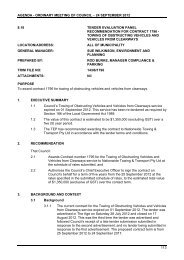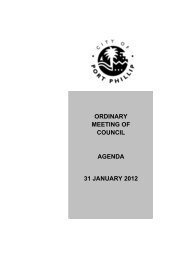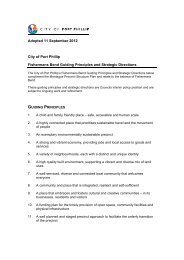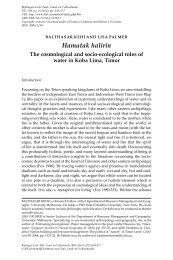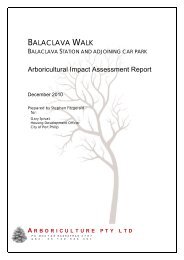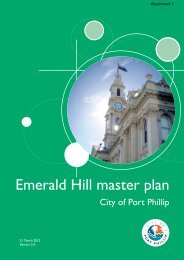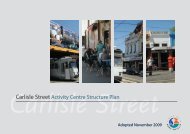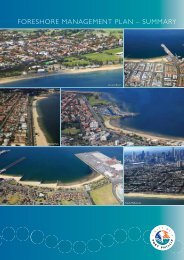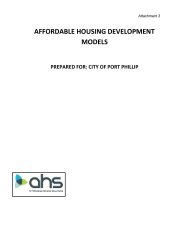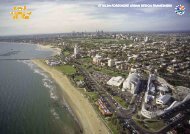Review of Heritage Overlay 1 Port Melbourne ... - City of Port Phillip
Review of Heritage Overlay 1 Port Melbourne ... - City of Port Phillip
Review of Heritage Overlay 1 Port Melbourne ... - City of Port Phillip
Create successful ePaper yourself
Turn your PDF publications into a flip-book with our unique Google optimized e-Paper software.
Figure 16<br />
Detail <strong>of</strong> <strong>Heritage</strong> <strong>Overlay</strong> map, showing the relationship between the existing<br />
HO1 precinct south <strong>of</strong> Graham Street. (outlined in red) and DDO1 (outlined in<br />
blue).<br />
3.3 Part 4a – Identification <strong>of</strong> smaller sub-precincts<br />
Discussion:<br />
The Project Brief required the reassessment <strong>of</strong> HO1 with a view to the identification <strong>of</strong><br />
‘smaller, more detailed and relevant/consistent areas and the corresponding boundaries’<br />
[Part 4a, refer p. 5 <strong>of</strong> the Project Brief]. This is as a response to the scale and diversity <strong>of</strong><br />
the area within HO1 and a perceived need to identify smaller areas with identifiable qualities<br />
and characteristics. It was considered that the identification <strong>of</strong> such areas and the<br />
preparation <strong>of</strong> more detailed citations reflecting their specific qualities and characteristics<br />
would assist the <strong>City</strong> <strong>of</strong> <strong>Port</strong> <strong>Phillip</strong> in its assessment <strong>of</strong> planning applications.<br />
In considering this issue, the historical themes identified in the earlier conservation studies<br />
were considered and the statement <strong>of</strong> significance for the existing HO1 was also reviewed.<br />
Out <strong>of</strong> this review, it is evident that one <strong>of</strong> the key attributes <strong>of</strong> the <strong>Port</strong> <strong>Melbourne</strong> HO1 area<br />
is its ability - in the breadth <strong>of</strong> the area - to demonstrate themes in the development <strong>of</strong> a<br />
working class maritime suburb developed from the mid-nineteenth century with some<br />
development also into the early twentieth century. While Williamstown is the other key<br />
example in <strong>Melbourne</strong> <strong>of</strong> such a suburb, there are significant differences between the two.<br />
The area as a whole contains extensive areas <strong>of</strong> nineteenth century workers’ housing,<br />
substantial numbers <strong>of</strong> hotels (for which <strong>Port</strong> <strong>Melbourne</strong> was well known), a range <strong>of</strong><br />
nineteenth and early twentieth century industrial buildings, a fine predominantly nineteenth<br />
century commercial shopping strip (Bay Street), and handsome civic and community<br />
buildings (town hall, police station and courthouse, fire station and others). The area also<br />
retains evidence <strong>of</strong> the transport links which underpinned the development <strong>of</strong> <strong>Port</strong><br />
L O V E L L C H E N 23



